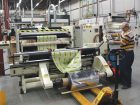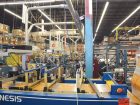
Alpha Poly Packaging Solutions of Brampton, Ont., for more than two decades primarily focused on the print production of polyethylene plastic bags, originally garbage bags before quickly moving into higher value food-service products, the latter of which was buoyed by an acquisition that basically doubled its size overnight. Alpha Poly’s February 2016 acquisition of Mikia Printing, a specialty flexible-packaging converter, however, speaks more to the company’s future.
The Mikia purchase is the most-recent example of a range of strategic investments led by Alpha Poly President Patrick Kerrigan, who took over leadership of the 50,000-square-foot operation in 2012, succeeding his father, Paul, who founded Alpha Poly in 1989. Kerrigan has been shifting Alpha Poly’s business approach since leading a lean-manufacturing audit in 2009, followed by a branding change, a new sales approach, and ultimately a multi-million-dollar capital equipment investment.
In 2013, Alpha Poly installed a massive 8-colour MIRAFLEX AM from Windmoeller & Hoelscher to produce higher-end process print jobs. This investment was followed by a decisive push to capture the growth in multi-laminates with a Nordmeccanica Super Simplex SL laminator. With the support of family members holding key leadership roles, including Matthew Kerrigan, Stephanie Kerrigan and Martin Boeykens, Alpha Poly is positioning itself as one of Canada’s leading independent companies in the robust flexography sector.
Kerrigan worked outside of the family business for 15 years after going to school for broadcast journalism at Mohawk College in Hamilton, Ont., which ultimately led to a career in post-production for television and movies. Kerrigan explains this experience allowed him to learn about his own approach in the business world before joining Alpha Poly. “I love to work with people and to mentor,” he says. “It is exciting to watch people grow – helping their families grow.”
Manufacturing measures
When Kerrigan led the lean audit for Alpha Poly in 2009, he faced difficult decisions of managing a manufacturing business, particularly one that has worked to foster a family-like atmosphere across the entire operation. Following the audit, Kerrigan estimates Alpha Poly reduced its labour by 30 percent and increased its output by 80 percent. “The return on investment was paid back in a year,” he says, noting how much discipline it took to institute the changes; for example, having one operator work two packing machines instead of a traditional one-to-one ratio.
Just prior to the lean-manufacturing audit, Alpha Poly had purchased the assets of a struggling London, Ont., operation that had succumbed to selling work below cost, an easy trap to fall into in any printing sector. “You need to know and understand your costs,” says Kerrigan, who was preparing to have the same lean analyst return in February to reset Alpha Poly’s base after the past three years of change management to branding and sales.
“It is great to see things moving ahead,” says Paul Kerrigan, who continues to attend major management meetings. “Patrick is driving the ship. We have a lot of good workers and that is a big part of making your business successful. It is exciting to come in and hear about all of the things going on.”
As he began to transition into leading Alpha Poly, Kerrigan leveraged years of broadcasting experience to evaluate the company’s brand position, which lacked a concrete marketing plan. Alpha Poly’s eight-year-old Website was in need of a revamp to better support the sales structure and any future manufacturing investments.
“When people heard about us, because our name used to be Alpha Polybag, the first thing was ‘Oh, you do the shopping bags for the grocery stores,’” Kerrigan says, noting the company had also been printing roll stock for a long time, as well as reverse printing on polyesters. “We re-launched our name to let people know we are not just a bag manufacturer.
“At that time, I knew the next phase of the company was to get into multi-laminates because you could see back then it was a growing market,” Kerrigan says, recalling reports that indicated multi-laminates would experience eight or nine percent worldwide growth year over year. “Everything is moving from rigids like plastic clamshells and jars to stand-up pouches, so I knew it was a market you wanted to be in.”
Developing new markets
Kerrigan explains a key driver of Alpha Poly’s strategy began to unfold in late-2012 when he crossed paths with David Mailman, who was helping to lead packaging manufacturer Multipak Ltd., which was in the process of shuttering its operation.
The high-end flexo knowledge of Mailman fit perfectly with Kerrigan’s plans to move Alpha Poly into new markets, which would require investing in the new press. “The stars aligned,” Kerrigan says. Mailman arrived in early 2013 to take over Kerrigan’s role as Plant Manager and to help direct the company’s capital investment.
This allowed Kerrigan to focus on melding Alpha Poly’s rebrand with a new sales approach. “I kept feeling that every time we came into our monthly management meetings we were always looking in the rearview mirror – what happened in the month before,” Kerrigan says.
He brought in an outside firm to review the sales strategy and a decision was made to implement the Salesforce.com CRM tool. At the time, Kerrigan explains Alpha Poly was generating healthy but flat annual revenue growth of around six percent. “We started setting targets for everybody and measuring,” he says. “People want to do better, but if you do not have anything to measure you do not know how well you are doing.” A sales roadmap was put in place to steer away from a shotgun approach and instead focus on what constitutes an ideal Alpha Poly customer.
In its most recent fiscal year, Alpha Poly experienced year over year revenue growth of slightly more than 20 percent. “We know where we are going because we can see everything in our pipeline,” Kerrigan says. “We can do accurate budgeting now… plus you have metrics that everybody is looking at.” The reinvigorated sales structure is also supported by a new business-development approach led by Kate Davis and former HP Canada trailblazer Debra Swift.
The February 2016 arrival of Vaughan Campbell, former owner of Mikia, who takes on a prominent technical sales role with Alpha Poly, helps establish one of the strongest senior leadership teams in Canadian flexography, with a technical and strategic ability to reach into completely new flexo markets. One of the most promising aspects of Alpha Poly’s new direction is that it currently only generates around five percent of its business from the United States.
With all of the investments in people and technologies, Kerrigan continues to focus on bottom-line growth. “We have to keep this cog going and we have really invested in this team to help us,” he says. “Our next goal… I would like to see in the next couple of years a 10-colour press in here.”
Print this page


